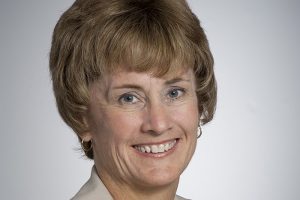Rory Hepner, general manager of vehicle logistics and distribution at Mercedes-Benz USA, reveals the premium carmaker’s measures to cope with growing volumes through plant yards, ports and across the transport network, despite limited physical expansion – whether by ‘valet’ services for truckers or working more carefully with plants and logistics providers to share advanced plans.
Over the past six years, Mercedes-Benz USA (MBUSA) has been riding the rising tides of the US and North American vehicle market with impressive balance. Not only have the Daimler subsidiary’s sales surged in the US, growing 85% since 2009 across Mercedes-Benz passenger vehicles, vans and Smart cars, but it has benefitted from vehicle localisation in the region, led by the Mercedes-Benz US International (MBUSI) assembly plant in Vance, Alabama.
To help meet rising demand, the carmaker has also invested strongly in its vehicle preparation centres (VPCs) at ports, where it carries out final quality inspections and accessory installations. Last year, it switched locations in the Los Angeles area to the new Mercedes-Benz West Coast Campus, located on the site of a former Boeing factory in Long Beach. The campus includes an expanded VPC, the ‘Learning and Performance Center’ and the Mercedes-Benz USA Western Region sales office.
However, the US vehicle market may be approaching a cyclical peak, with sales of sedans and luxury vehicles mostly in decline this year compared to 2015 as consumers race to buy a spate of new SUVs, trucks and crossovers. Thanks to some fortuitous capacity and product decisions, Mercedes-Benz is holding its position better than its premium competitors, with sales stable in the first half of the year. Meanwhile, production across its US plants is up strongly thanks to a new SUV model at Vance, as well as strong exports.
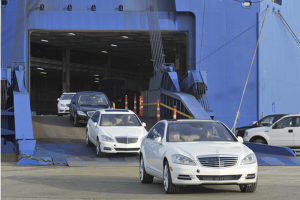
But the carmaker is positioning itself to grab a bigger, more profitable slice of the US market. By 2018, production of Mercedes-Benz compact cars will start at a new joint-venture plant with Nissan’s Infiniti brand in Aguascalientes, Mexico, which is expected to reach capacity of 150,000 units for the brand by 2021. In autumn last year, the carmaker also announced a $1.3 billion investment in Vance to build more SUVs; and it has further plans to replace a knockdown kit assembly plant for Sprinters in Ladson, South Carolina with a full-cycle plant in Charleston.
Daimler is also reorganising global production to create more capacity for SUVs as quickly as possible. Last year, it started using AM General in Mishawaka, Indiana to build the R-class for export to China, freeing up space for SUV output at Vance. Elsewhere it will use contract manufacturer Valmet in Finland to supplement output of the GLC SUV by 2017, including models that will go to the US.
With nine vehicle launches or redesigns planned over the next year in the US, Mercedes-Benz is determined not to let up on the market and vehicle logistics will play an increasingly important role in this plan.
Living in the realityIn the US, the team that will handle many of the strains of getting those cars to dealers is MBUSA’s Atlanta, Georgia-based vehicle logistics and distribution department, led since 2011 by general manager Rory Hepner.
Hepner and her team are the ‘doers’ of the company’s finished vehicle logistics, responsible for monthly vehicle ordering from plants to fulfill US demand; communication with dealers, VPC and import operations; and the logistics of all vehicles for MBUSA brands across US soil. Most of the carmaker’s logistics providers in the US deal with the distribution team almost every day concerning deliveries and vehicle handling.
Contract negotiations and network planning, meanwhile, are separate.
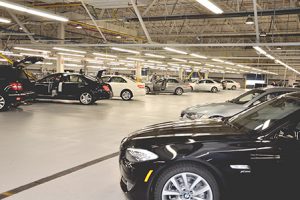 The company has invested strongly in its vehicle preparation centres to help it meet its growth aspirations
The company has invested strongly in its vehicle preparation centres to help it meet its growth aspirationsThe logistics procurement team is based alongside the logistics team in Atlanta and the two work closely together, however Hepner reports to the vice-president of sales at MBUSA, while purchasing reports both to finance and to a NAFTA logistics organisation at the Daimler Trucks North America headquarters in Charlotte, North Carolina.
The NAFTA team, which was established around four years ago, is responsible for logistics network design across Daimler plants and sales in North America, including passenger vehicle, heavy truck and component brands.
Long-term sales planning, which includes order and production outlooks over one to three years, is also separate from distribution (although they used to be together).
This structure allows Hepner’s team to act as a service centre for wholesalers focused on monthly targets.
Those in logistics and distribution, as Hepner says, “live in the reality”.
“And things change in reality depending on inventory availability, ship delays or plants constraints. We look at what sales planners think we should do, and we do what is possible based on what is right for the market,” she says.
However, Hepner also works with other Daimler divisions in North America and Germany to develop strategic plans that look further out than a month, which are shared with dealers and logistics providers. For example, recent growth and model shifts have been so significant that an existing plan through 2020 is now being updated.
“We need to manage growth and capacity on a daily basis, but you also need a strategic plan for how you handle volume in the long term for our dealers, wholesale targets, logistics partners – the whole network.”
A growing networkMercedes-Benz has expanded its production and vehicle logistics network significantly since the global financial crisis, with considerably more growth earmarked for investment.
The MBUSI assembly plant in Vance has become one of the carmaker’s most important global factories, its output rising nearly 250% since 2009 with the introduction of the C-class sedan for the North American market together with the GLE (formerly M-class) and GL SUVs and, most recently, the GLE Coupe SUV. Last year, Mercedes-Benz freed up more space at Vance by outsourcing R-class production to AM General in Indiana.
In 2010 the carmaker also opened Ladson, South Carolina to assemble Sprinter vans, which has since added new models and capacity, although this will be converted into a full assembly plant in Charleston in coming years.
Although the carmaker’s local production growth in the US has been highest, and the localisation of the C-class and SUVs has reduced demand for imports, MBUSA has seen stable volumes of high-value models from Germany and compact models from Hungary. MBUSA has thus maintained capacity across its ports of import, where the carmaker does important post-production and accessory installation at its VPCs.
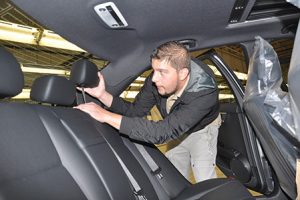 Mercedes-Benz USA operates three vehicle preparation centres in Baltimore, Brunswick and Long Beach, where it installs accessories and inspects vehicles before delivery to dealers
Mercedes-Benz USA operates three vehicle preparation centres in Baltimore, Brunswick and Long Beach, where it installs accessories and inspects vehicles before delivery to dealersThe carmaker’s largest VPC is in Baltimore, Maryland, which covers the north-eastern states and the Midwest, handling around 40% of imports, according to Hepner. In 2014, MBUSA and BMW ended an agreement in which Mercedes-Benz processed BMW vehicles at Baltimore, freeing up space at the terminal. Since last year, Baltimore has also handled exports of the R-class to China from Indiana.
Imports for the south-east region move through Brunswick, Georgia, where MBUSA opened a new VPC in 2010 after it switched from Jacksonville, Florida; it handles around 30% of import volume. The port of Brunswick also handles a majority of exports from Vance, while some exports also move out of Savannah, Georgia and Jacksonville.
Most recently, MBUSA switched from a terminal in Carson City to a 1m sq.ft (93,000 sq.m) campus in Long Beach, California, which includes a new VPC as well as a regional sales and training office. Long Beach, which handles around 30% of imports, was the culmination of more than two decades of searching for a bigger VPC location in southern California.
Mercedes-Benz also uses the port of Charleston, which handles kits for assembly at Ladson as well as a small number of imported finished Sprinter vans.
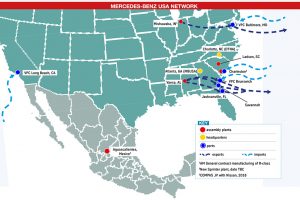 Mercedes-Benz USA network – click to enlarge
Mercedes-Benz USA network – click to enlargeThe shifts in MBUSA’s production and logistics network are reflected in the subsidiary’s move last year from Montvale, New Jersey to Atlanta, Georgia. With Mercedes-Benz production in the South, along with other Daimler entities, MBUSA’s management is now closer to its core operations. Compared to two flights from New Jersey, Vance and Brunswick can be reached by car in several hours.
“I was fortunate that a good portion of my staff made the move to Atlanta, which is helping us make the transition with our new team members in a quicker and more efficient manner,” says Hepner. “What we can do in Atlanta better than New Jersey is get staff to see and be a part of the Ladson and Vance plants and VPC operations, which allows them to have a better understanding of what they are doing and how it impacts the operations.”
With the Mexico plant later this decade, there may be changes or additions to this network, whether at ports or inland yards, although Hepner says those plans have yet to be finalised. For MBUSA, Mexico will be treated the same as any overseas plant, and it will not have operations at the plant marshalling yard, for example.
Some Mexico-built vehicles may ship by short-sea to existing MBUSA ports, although it is worth pointing out that rail links from Aguascalientes already serve much of the US market for Nissan. According to Hepner, lower lead times and handling points are preferred in any delivery strategy, however it will also be important to ensure that the vehicles meet the same quality, accessory options and reliability that dealers expect from the network today.
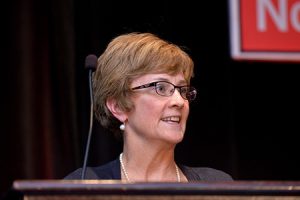 Hepner: 'layered storage approach'
Hepner: 'layered storage approach'Interview: A new permanent homeChristopher Ludwig (CL): You’ve been in the role five years now and have overseen tremendous growth. What strategies have helped the network cope?
Rory Hepner (RH): "We have become creative in dealing with the volume increase. There are times when we don’t have enough capacity and we have to come up with new ideas to deal with it. For example, we have implemented a ‘layered storage approach’. When vehicles are held for whatever reason, we try our best to keep them within our normal supply chain; however, if we are running out of space at plants or ports, we have processes to establish external yards or storage quickly. Once the issue is dealt with, we pull vehicles back into our supply chain as quickly as possible.
"One of the biggest accomplishments over the last five years was also finding and moving into new a permanent home in Long Beach for our west coast campus and VPC, which we moved into in May 2015. Our previous terminal in Carson City was under capacity for many years and now we have a much better facility. We are still growing into it, and some of the things we planned while we were building the facility need to be adjusted, but it has been a success and a great opportunity for us to support our volumes on the west coast. We now have three VPCs, all of which have capacity to handle our volume and our growth in the future."
CL: What effect is Long Beach having on your operations?
RH: "It is a very good VPC for capacity and throughput. It has meant big changes for our trucking companies, as they now have sufficient space for loading, while the parking layout and capacity allow for more efficient operations. We still need to shunt vehicles to the terminal from the port, but from a throughput standpoint, the trucks can come in, get vehicles and get out in a much more timely and operationally efficient manner. That is a big advantage to our carriers as well as our dealers and customers.
"The location is generally the same distance from the port of Long Beach as the previous location, but the housing of three different areas of responsibilities in one campus – VPC operations, sales operations and training – is extremely beneficial from a cost and operational standpoint. For example, there are synergies in communication between logistics, distribution, sales and training in distributing vehicles to our dealers. But it is also an advantage for career progression among our employees, since we can do exchanges across different areas. We hope there will be great growth opportunities for our employees."
CL: Do you generally have labour concerns for your employees at the VPCs, whether in terms of turnover, skills shortages or training, especially given there is some complex post-production work?
RH: "We are always thinking about how to keep our employees’ skills up to date, however we focus on accessories that we can install easily and quickly to avoid delaying vehicles too long. That also helps us to maintain a stable labour force."
CL: Have you been able to improve scheduling stability and throughput at VPCs and yards?
RH: "It has been a big area of focus and we’ve had success, especially from Vance. We’d like to get the same level of reliability for imports from Europe, but it is difficult. It depends on the stability of production. But we also need to look carefully at the vehicles available to us, including those arriving by ship, so that we can determine how best to plan processing through a VPC and where they need to go, based on demand. That is a daily function of the VPC and things change constantly. There is an operational plan we put together on a daily basis, but once we start seeing the vehicles that are on the ship, we fine-tune the objectives and timings up to and including when they are in the VPC."
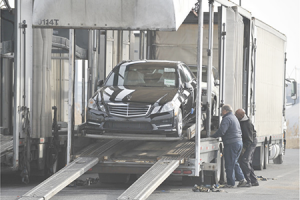 A ‘valet service’ at VPCs and marshalling yards helps carriers manage their fleets and avoid waiting times through communication of optimal pick-up windows
A ‘valet service’ at VPCs and marshalling yards helps carriers manage their fleets and avoid waiting times through communication of optimal pick-up windowsHelping carriers have more confidenceCL: Have you expanded other VPCs as well? If not, how have you coped with growth?
RH: "We haven’t physically expanded them, but we have made operational improvements to how we get vehicles through them. We can’t just keep adding land, so you need to get more disciplined in how you assign and dispatch vehicles.
"For example, we have established a ‘valet service’ at every VPC and plant marshalling yard where the dispatcher sends drivers out to bring the required vehicles to trucking carriers, which prevents carriers having to enter the yard to find them. That, together with our layered storage approach, has helped us cope without adding permanent capacity."
CL: Have trucking carriers responded well to that?
RH: "Yes, we’ve had a positive response from carriers. It helps us manage how many trucks we can load at one time and makes loading more efficient, because carriers wait less time when the yard is crowded. It also allows better communication – if we have valets working and we know how many trucks are at the yard, then we can tell our providers whether now is a good time to come or not. That helps carriers to manage their fleets more effectively."
CL: Has extending night and weekend deliveries played a role in relieving capacity constraints?
RH: "That has been successful. We are always marketing extended night and weekend deliveries and our success rate in getting dealers to participate continues to increase. We will continue with this marketing trend because we are convinced that it is in dealers’, customers’ and our carriers’ best interests to do so."
CL: Have you considered increasing service contract length with logistics providers to help them manage capacity better?
RH: "We believe it is important to develop partnerships with our carriers, because the demand for carriers is exceeding supply. Extending the length of contracts allows our carriers to have even more confidence in our relationship and in turn gives additional confidence to invest in their people and equipment, which is in our best interests as an OEM."
CL: Do you allow carriers to co-load vehicles from yards?
RH: "We try very hard to provide dealers with full loads so that we can avoid co-loads."
Getting a handle on the right vehiclesCL: For several years, production in Vance had been more weighted towards exports than imports. With the addition of the C-class and new SUVs, that appears to have changed. What has that meant for vehicle distribution?
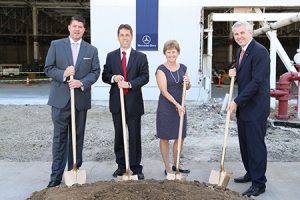 Hepner with colleagues at the ground-breaking ceremony for the Long Beach VPC, which she is confident will play a key role in handling future Mercedes volume and growth
Hepner with colleagues at the ground-breaking ceremony for the Long Beach VPC, which she is confident will play a key role in handling future Mercedes volume and growthRH: "The split between domestic and exports in Vance is weighted slightly higher to the domestic US market and North America, so the balance has changed again for us. That is helpful for MBUSA because we are very focused on the US market and making sure we get vehicles to our dealers as soon as possible. SUVs are in demand globally and plants are doing what they can from a capacity standpoint to meet that demand worldwide, including in the US."
CL: Did MBUSI expand the marshalling yard at Vance in line with the production growth?
RH: "The Vance marshalling yard footprint was not expanded, but we have done things to add capacity, including the measures I’ve already mentioned. We have also been very fortunate that our rail providers and carriers have been very good in helping us get the right throughput out every day. We have limited space and so if there is a hiccup, we run into issues quickly, so we need strong providers."
CL: I understand that the plant marshalling yards are outsourced to providers, while at ports MBUSA staff operate VPCs. Why is there a difference?
RH: "The marshalling yards are based on the premise that the vehicles come directly out of production and are loaded for the final destinations. MBUSA manages a third party to do the actual movement of the vehicles on behalf of the US market and exports. On the other hand, VPCs receive vehicles from overseas and need to have quality checks performed prior to being loaded by truck for the final destinations. The quality inspections, repairs, campaign management, prioritisation of vehicle release and tender of loads is done by MBUSA’s staff.
"However, just as in the marshalling yards, any movement or shuttling of the vehicles at the VPC at ports is also done by a third party."
Lessons in manufacturing and logisticsCL: Have you been able to work with plants more closely when it comes to quality holds or changes that might otherwise disrupt distribution?
RH: "We do have issues that are challenging. Overall, I would say there has been a big improvement in cooperation and understanding by the plants over what impacts vehicle logistics and why, which has helped us tremendously. It is not perfect, but there has been a big improvement on both sides, mostly the result of communication and collaboration.
"For Europe, it is a little different than local plants – we’ve got that ocean between us, after all. But we’ve been able to apply lessons from Alabama. For example, the European plants have gotten much better at giving us information about vehicles that might be delayed, or which cannot be released immediately after they’ve been unloaded.
"It is challenging as everyone has their own areas where they are responsible, but we are seeing signs all the way up to the highest executive levels at Daimler that show more consideration across the supply chain, and more understanding of how a glitch in one area can impact others. That is a huge change. It is not perfect, but at least there is now a conversation."
CL: Do you offer dealers an estimated time of arrival (ETA) from the point of order? If so, how accurate is this?
RH: "At the point of order, dealers provide customers with an ETA based on information they see in our sales system, NetStar. Based on where the vehicle is in the supply chain – from pre-production to in-transit to the dealer – an ETA could be several months in the future, so the closer the vehicle is to the dealer, the more accurate the date provided. Once a vehicle is released for final delivery to the dealer, MBUSA uses historic averages to calculate the ETA of each transport leg. This information may be updated periodically to reflect actual delivery variables.
"Based on a recent MBUSA dealer survey, a majority of our dealers are satisfied or very satisfied with the accuracy of ETA information we provide."
CL: Do you have a priority system that allows vehicles to move faster through the supply chain, such as a sold model versus a stock one?
 RH: "Yes, we do have a priority system and it allows us to manage the processing, distribution and loading of our vehicles to dealers.
RH: "Yes, we do have a priority system and it allows us to manage the processing, distribution and loading of our vehicles to dealers.
"The most important priority is the customer priority. We’ve had this process for years and we continue to tweak it to improve our inventory management and distribution processes."
CL: How much of a challenge for logistics is Mercedes-Benz’s aggressive model launch over the next year going to be in terms of distribution?
RH: "It’s a huge challenge for our network, as that is a lot of volume to manage. We’re taking actions like giving our logistics providers more advanced information, including sharing changes every week across our weekly, monthly, quarterly and annual plans and forecasts for each carrier.
"In the end, however, we will meet our delivery requirements. That is what you’ve got to love about logistics: one way or another, we will get it done. We will order the vehicles, we will handle the dealers’ questions, distribute the vehicles and manage the carriers, because that is our job."
"That is what you’ve got to love about logistics: one way or another, we will get it done. We will order the vehicles, we will handle the dealers’ questions, distribute the vehicles and manage the carriers, because that is our job." - Rory Hepner, Mercedes-Benz USA

























![Global[1]](https://d3n5uof8vony13.cloudfront.net/Pictures/web/a/d/s/global1_726550.svgz)




